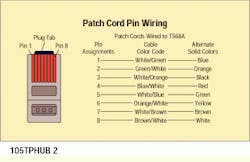Finding the culprit in Category 5 links gone bad
Sue (M.E.) Lemay, RCDD, Hubbell Premise Wiring Inc.
Problem
You have cabled and tested your entire horizontal cabling system to Category 5 basic link-performance parameters, from patch panel to wall jack, before starting up the system. But, once the system goes live, you have workstations that are unable to communicate properly with the network.
This is a cabling nightmare that can happen to the best of installers, and the cause of the problem is sometimes difficult to detect. Because modular patch cords that connect equipment to the network are omitted from basic-link testing, they are most likely the source of the problem.
Solution
You will need to determine if the modular cords are causing performance degradation. If so, replace them with cords whose performance has been verified either by the manufacturer or by use in an active system.
Procedure
This procedure assumes that the overall channel link consists of a wall jack, 90 meters or less of horizontal cable, a patch panel and 10 meters or less of modular patch cords.
1) Disconnect the horizontal cabling from the station equipment and the system equipment, leaving the patch cords plugged into the wall outlet and the patch panel.
2) Retest the near-end crosstalk performance of your cabling from both the workstation and the patch panel ends. If excessive near-end crosstalk is present, remove the cord on that end and test again, using the cord supplied with the test unit. If the tester records a pass for near-end crosstalk, replace the test cord with a known good cord and test again to verify.
3) If excessive near-end crosstalk is present when using the cords supplied with the test unit, you may have a more serious problem, such as electromagnetic interference. You should check for possible trouble sources that may have been introduced after the initial link testing.
4) The suspect modular cords can often be detected using a link-performance tester or through visual inspection:
--Verify that the cords were built using the correct pairing/pinning.
--Check that the cable has been assembled using Category 5 cable.
--Look for "skiving" that occurs when the plug is not positioned properly in the tool when crimping. Skiving occurs when the crimp tool scrapes a sliver of plastic from the side of pins 1 or 8, or both, which can prevent proper contact when the connector is plugged into a jack. [For more information, see "Locating bad crimps," July 1995, page 43. Ed.]
Although these visual inspections may help locate a problem, modular patch cords designed to operate in a Category 5 system require special assembly and testing techniques that must be followed to ensure correct performance. For these reasons, it is recommended that you use cords that have been factory-assembled and -tested.
Sue (M.E.) Lemay is technical services engineer at Hubbell Premise Wiring Inc., in Stonington, CT.
Patch cords wired to T568A are interchangeable with those wired to T568B. For the latter, white/green, green/white appear on pins 3 and 6 and white/orange, orange/white appear on pins 1 and 2, respectively. For cords assembled using solid conductor cable, different solid colors apply.

